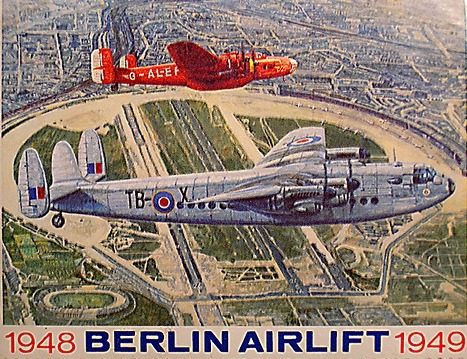
The following extracts are taken from a much larger article in the ‘Burtonwood Times’ volume 22 No.1 (Spring 2008) entitled: Veterans of the greatest humanitarian airlift in history recall the experiences. It began 60 years ago this month. THE BERLIN AIRLIFT. By Stewart M Powell
The extracts selected contain references to the RAF Airfields in Germany, Celle and Fassberg and are quoted verbatim.
However the operation needed more than just speedy ground operations. Germany’s notorious fall and winter weather loomed on the horizon. Within weeks of Tunner’s ( Maj. Gen. William H Tunner) take-over, his task force launched a determined effort to cut down the two-hour flight times between Berlin and the two main bases in the West, Rhein-Main and Wiesbaden. Tunner’s team first settled on the RAF base at Fassberg from which Berlin could be reached in 55 minutes’ flying time. The first C-54s flew out of Fassberg on Aug. 21st 1948.
(Marcus C) West, who flew out of Fassberg, remembers flying two weeks straight in one 12 hour time slot, taking three days off, and then changing shifts to fly two weeks straight in a shift that began eight hours later.
Aircrews grabbed shut-eye whenever they could. At Fassberg many personnel bunked in three storey, red-brick buildings that unfortunately had the acoustics of an echo chamber.
Marcus C West (a retired Air Force Colonel) remembers coal bearing trucks rolling towards his returning airplane at Fassberg even before he cut the engines. ‘By the time the flight engineer had the giant rear hatch open … the German coal truck would be stopping within inches of the loading hatch’ recalls West. Ten workers ran an oval racetrack pattern from the truck to the front of the cargo bay with bags of coal. The average turnaround time at Fassberg was 21 minutes. West says, adding, ‘‘The record for a turnaround was an unbelievable 7 minutes’.
A Fassberg based C-54 completed the round trip to Berlin in 1 hour 57 minutes, with ground turnaround time of 15 minutes 30 seconds.
At Celle, a former Luftwaffe fighter base in the UK sector, the British began building a 5,400 foot runway to enable American C-54s to use the base as well. Tunner moved the 317th Troop carrier Group from Wiebaden to Celle by Christmas.
Hugh C Kirkwood (Retired Master Sergeant) a former gunner on a B-25, worked as an approach co-ordinator in the Celle tower. ‘It was the usual thing – getting blocks of aircraft off and getting aircraft rolling into final approach,’ recalls Kirkwood a 21 year USAF veteran. ‘Timing was the most essential thing. You’d be landing and launching aircraft on the same runway. Every pilot knew they had to do it right’.
Aircrew were so busy flying two or three missions a day, that few ever saw the Berliners they were feeding. Ford M Garwin, who worked at Celle setting up the briefing system for aircrews, says the Berlin assignment was demanding on everyone. ‘Thirteen hours on, eleven hours off, seven days a week, recalls Garwin ‘ It was six months before I got a day off but still it was the best military operation I’d ever been a part of. It had precision. It worked’.
(George) Hoyt, a B-17 crew member in WWII, who returned to active duty to help set up control tower operations at the British base at Celle, found that delivering food to starving Berliners offset any regrets about the wartime necessity of bombing Nazi Germany.”
The Allies kept up deliveries, waiting until July 30th 1949 to announce a target date for ending airlift deliveries. Phase out operations began in earnest. The Celle based 317th Troop Carrier Group flew its final mission into Berlin on July 31st 1949. C-54s began leaving Rhein-Main for the USA in early August. By August’s end, the Fassberg based 313th Troop Carrier Group had completed its last mission into Berlin.
Further reading on the Berlin Blockade can be found by clicking here.
